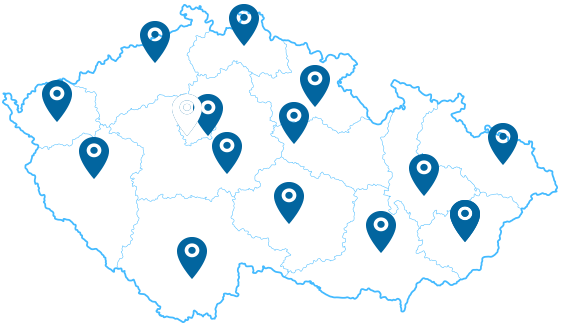Specified risk material (SRM)
The term specified risk material (SRM) covers animal tissues listed in Annex V to TSE Regulation (EC) No. 999/2001. The tissues are the following:
Bovine animals
Since August 2015 the operators in the Czech Republic may remove as SRM in bovine animals the skull excluding the mandible and including the brain and eyes, and the spinal cord of animals aged over 12 months only. This possibility is in accordance with Commission Regulation (EU) No. 1162/2015 and apply only for animals from Member States with negligible BSE risk status.
Ovine and caprine animals
- the skull including the brain and eyes, the tonsils and the spinal cord of animals aged over 12 months or which have a permanent incisor erupted through the gum; and
- the spleen and ileum of animals of all ages.
Feed ban on meat-and-bone meal (MBM)
The ban on feeding meat-and-bone meal originating from ruminants to ruminants was issued in the Czech Republic already in the year 1991; however, even before that date, protein of animal origin had not been included in formulas of compound feedingstuffs for adult bovine animals.
On 1 September 2003 and in accordance with Community legislation was adopted by which a complete ban on feeding meat-and-bone meal (total feed ban) to all farm animals has been imposed since 1 November 2003.
The ban on feeding animal protein to ruminants is set out in Article 7 of TSE Regulation (EC) No. 999/2001.
Testing for TSE (BSE)
From 1 July 2013
In autumn 2012, the EFSA (European Food Safety Authority) submitted a scientific study assessing BSE risk in Europe. Very favourable conclusions of the study inspired the European Commission to further review age limits for testing of bovine animals for BSE which resulted in a legislative proposal of possible future complete cancellation of BSE-testing of healthy animals slaughtered at slaughterhouses in all Member States, excluding Bulgaria, Crotia and Romania; the proposal was subsequently adopted as Commission Implementing Decision No 76/2013/EU of 4 February 2013 amending Decision 2009/719/EC authorising certain Member States to revise their annual BSE monitoring programmes. However, not all Member States have made use of this option and have continued in testing of healthy bovine animals.
Based on a favourable animal health situation with respect to BSE where the last BSE case was recorded in the year 2009, the Czech Republic has made use of this cancellation of BSE-testing of healthy animals slaughtered at slaughterhouses and reviewed its BSE monitoring from 1 July 2013 as follows:
a) healthy bovine animals slaughtered at slaughterhouses:
• all animals over 30 months of age born in Bulgaria, Croatia, Romania or in third countries
b) sick ante mortem slaughtered animals:
• all animals over 24 months of age.
c) emergency slaughtered animals:
• all animals over 24 months of age.
d) suspect animals:
• all animals, irrespective of age and origin.
Monitoring in sheep and goats shall proceed as follows:
a) healthy animals slaughtered at slaughterhouses or within domestic slaughter:
• no animals are tested.
b) dead and killed animals:
• all animals over 18 months of age.
c) animals suspect of TSE (scrapie):
• all animals, irrespective of age and origin.
Testing for TSE is currently performed at laboratories of 3 State Veterinary Institutes (in Prague, in Olomouc and in Jihlava which is at the same time the National Reference Laboratory for TSE) using approved tests and methods listed in Annex X to TSE Regulation.
Since the beginning of an active BSE monitoring in bovine animals, i.e. since 1 February 2001, the BSE have been found only 30 positive BSE cases. Last positive BSE case was detected in May 2009. From 30 positive animals, 13 normally slaughtered animals, 8 emergency slaughtered animals and 8 dead animals were concerned; 1 animal was included in the group (cohort) of animals to be killed in the context of previous positive BSE case.
Since 2002, in frame of TSE monitoring in ovine and caprine have been found 62 cases of scrapie on 13 holdings totally. All cases were diagnosed in ovine animals and 8 of them were classified as atypical scrapie case.
 (43.7 KB) From 2014 a 2015 the Member States have begun with recognition of TSE risk status on holding with ovine and caprine animals. The condition for recognition of TSE status are laying down in Annex VIII of TSE Regulation. The recognition of TSE status is voluntary upon request of breeder and it is primarily intended for farmers who trade with live animals within EU. The holdings may get 2 types of TSE status. First and the best is the negligible TSE status. This status can be recognised to holding which fulfil conditions set out in Annex VIII of TSE Regulation for at least 7 years. The second status is the controlled TSE risk status which can be recognised to holdings fulfilling the same conditions for at least 3 years. Today only Austria, Finland and Sweden have recognised negligible TSE risk status for whole country.
(43.7 KB) From 2014 a 2015 the Member States have begun with recognition of TSE risk status on holding with ovine and caprine animals. The condition for recognition of TSE status are laying down in Annex VIII of TSE Regulation. The recognition of TSE status is voluntary upon request of breeder and it is primarily intended for farmers who trade with live animals within EU. The holdings may get 2 types of TSE status. First and the best is the negligible TSE status. This status can be recognised to holding which fulfil conditions set out in Annex VIII of TSE Regulation for at least 7 years. The second status is the controlled TSE risk status which can be recognised to holdings fulfilling the same conditions for at least 3 years. Today only Austria, Finland and Sweden have recognised negligible TSE risk status for whole country. (9.7 KB)
(9.7 KB)  Post
Post


